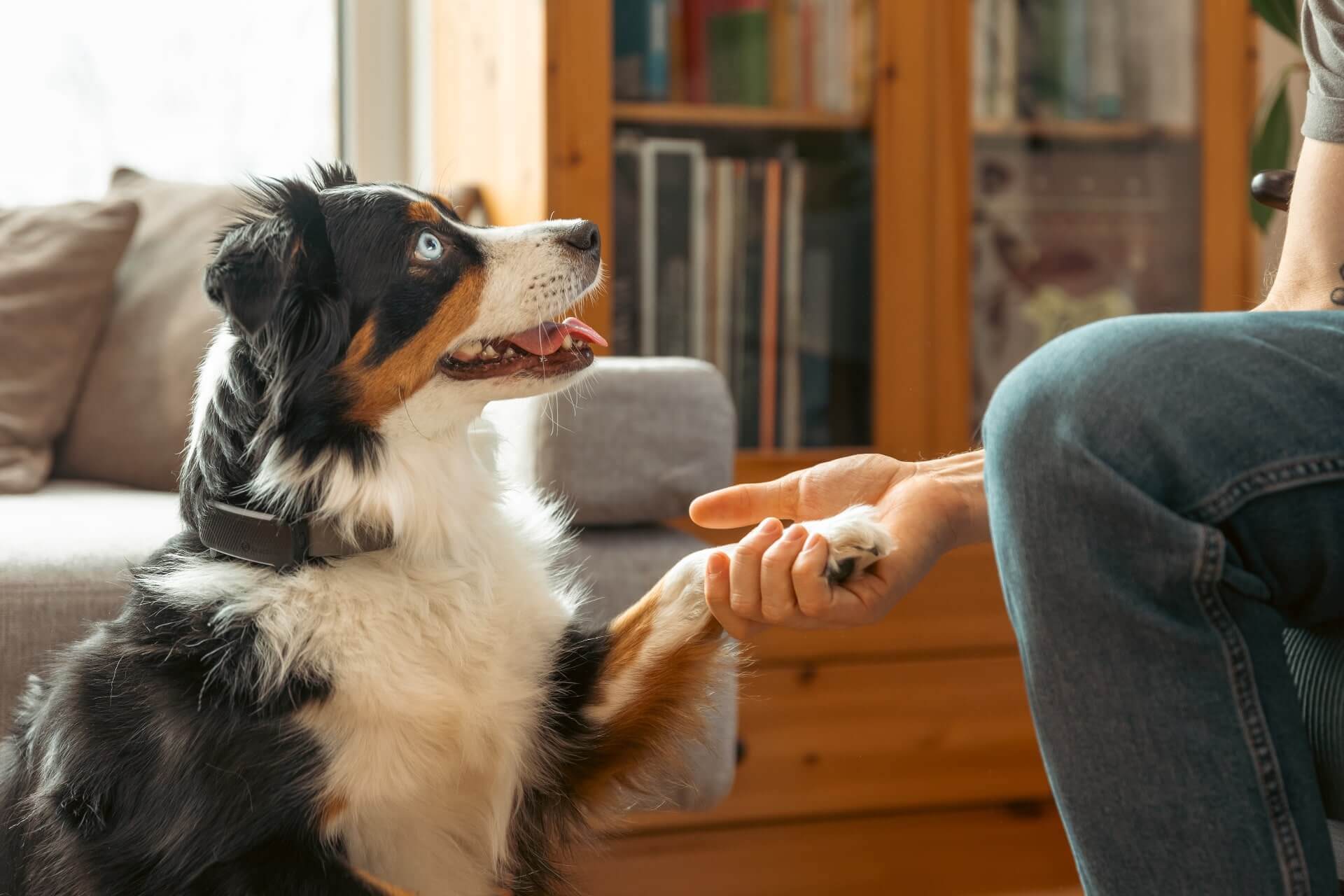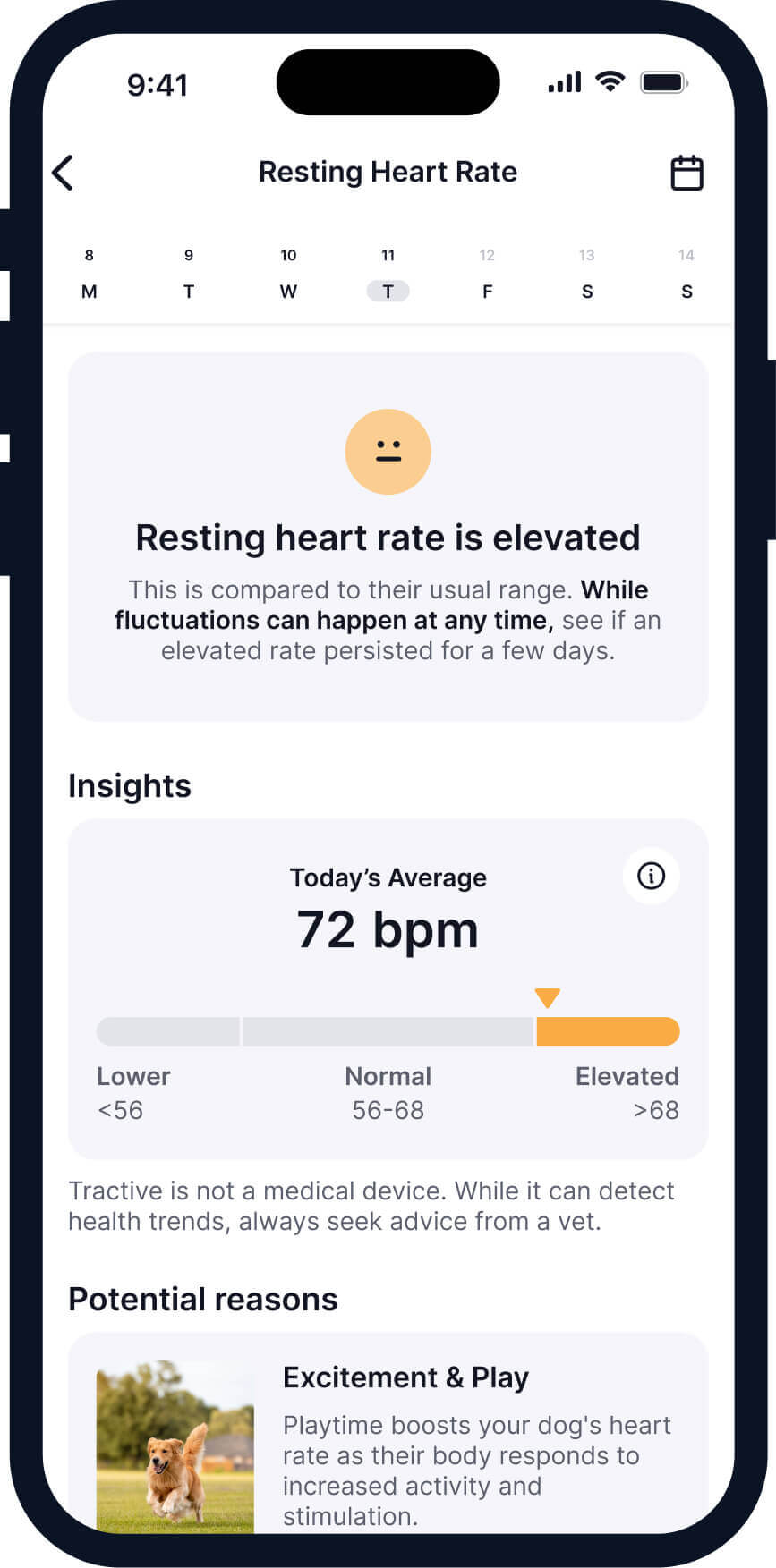 Approved by Dr. Dwight Alleyne, DVM
Approved by Dr. Dwight Alleyne, DVM 8 Signs Of Intestinal Blockage In Dogs & How To Deal
Watching your dog straining or struggling to go to the toilet can be painful enough - but what if you're dealing with an intestinal blockage? Here's how to spot it early.

If you’re noticing your buddy straining more or just having some toilet trouble, you might’ve wondered if they’re backed up – and how you can help. Here are all the signs of intestinal blockage in dogs – as well as what you can do to help your buddy feel better and some steps you can take to monitor their health and wellbeing.
Key Takeaways
Intestinal blockages in dogs can be life-threatening – early detection is crucial. The sooner you spot the signs and get your dog over to a vet, the better.
Watch out for signs like diarrhea, vomiting, constipation, a swollen, tender abdomen, and lethargy.
Tractive’s Health Monitoring features can help you spot the early warning signs by tracking your dog’s activity and sleep quality, vital signs (including their breathing and heart rate), and can alert you if there’s a weird change.

Always know your buddy is healthy & safe
Read more- Why is an intestinal blockage so dangerous for dogs?
- The main c auses of intestinal blockage in dogs
- Signs of blockage in dogs: What to look out for
- Diagnosing bowel obstruction in dogs: What to expect at your vet’s
- How your vet might treat an intestinal blockage
- How to care for your buddy once they’re back home
- Where a smart dog tracker can help
What is an intestinal obstruction?
An intestinal obstruction is when your dog’s intestinal passage has something blocking it. Your dog might experience a partial blockage (where some food can still pass through) or a complete blockage (where no food passes through.)
With an intestinal blockage, any food your dog eats doesn’t pass through their intestines as easily. With time, this food accumulates – because your dog’s intestines aren’t able to digest it. This undigested food may attract bacteria, which can severely damage the intestinal wall. This may cause your dog severe pain – and may even threaten their life and health, left untreated.
Why is an intestinal blockage so dangerous for dogs?
If your dog’s intestines aren’t able to pass through food, your buddy won’t be able to absorb or digest any nutrients or energy from it. With time, this can lead to their intestinal walls getting damaged – which may even result in a rupture. This undigested food may release into their abdominal cavity, which can lead to inflammation and blood poisoning. A bowel obstruction can even lead to “ileus” or the loss of movements in their intestines. Meaning if you don’t take action as soon as possible, an intestinal obstruction may even threaten your dog’s life.
The main causes of intestinal blockage in dogs
- Your dog’s swallowed a foreign object
Like a toy, hairball, fruit stone, or even grass. When these objects tend to be large, hard, and/or indigestible, it may cause a bowel obstruction. - Digestive problems
Especially if your dog has eaten something they shouldn’t have. This can cause their intestines to pass food slower. In more serious cases, this could end up in a “paralytic ileus” or an intestinal blockage resulting from your dog’s intestines slowing down significantly. - Other medical conditions
Which could include inflammation, poisoning, tumors, cancers, parasites, hernias, or even neurological problems.
Signs of blockage in dogs: What to look out for
Here are some of the most common signs of intestinal blockage in dogs to watch out for – though they might vary, depending on what your dog is experiencing. These symptoms can last for several days to weeks.
- Diarrhea
- Vomiting (especially gushing vomit of any food or liquid)
- Constipation, straining, or inability to defecate
- Loss of appetite
- Emaciation
- A swollen, tender, and/or bloated abdomen
- Lethargy
- Fever
In the case of an incomplete or chronic bowel obstruction, these signs may initially be less obvious. Which means you might actually miss out on them entirely – until your dog’s health has worsened.
Besides, in more serious cases, a bowel instruction may even lead to death within a few hours without treatment.
Diagnosing bowel obstruction in dogs: What to expect at your vet’s
First, your vet will do a thorough physical checkup of your dog. They might palpate the abdomen to check for any pain or discomfort. They will also take your dog’s temperature and examine their oral cavity.
After, your vet might carry out some diagnostic tests to determine what’s causing the intestinal obstruction. These may include X-rays, endoscopy, or ultrasound examinations of your dog’s abdomen to check for foreign objects or other blockages. A blood and/or urine test can help check for inflammation or poisoning. If it’s a particularly serious cause of obstruction, your dog might need to undergo surgery.
If your dog’s symptoms have spread to their esophagus or stomach, your vet might need to exmaine them under anaesthesia..
How your vet might treat an intestinal blockage
Depending on what’s causing your dog’s intestinal obstruction, your vet might prescribe:
- A surgical procedure, especially if it’s a foreign body – or if a section of your dog’s intestines have been permanently damaged
- Fluid therapy
- Specific medications to get things going in your dog’s intestines
- A special diet to put your dog on as they heal (involving easy-to-digest foods)
Following the operation, your buddy might have to stay at your vet’s for a few days – so they can heal and your vet can follow up on any other treatments required. They may be on a dose of painkillers until they’re feeling better again.
How to care for your buddy once they’re back home
- Keep your dog’s neck collar on until any stitches from their surgery have been removed. They might be compelled to lick or scratch at these, which may cause any bacteria from their mouths to infect the wound. (Resulting in another surgery.)
- Follow your vet’s instructions regarding any special medication or diet they prescribe you. At this point, they should only be eating healthy, easily digestible foods.
- Call your vet immediately if you notice any weird symptoms or a resurgence of vomiting, diarrhea, or abdominal pain.
- In some cases, your vet might recommend you regularly take your dog’s temperature at home.
- Be mindful of any toys or other “chewable” objects lying around home. Keep them well clear of your dog (even after they’ve healed.)
- Avoid feeding your dog foods like bones. These may splinter in your dog’s mouth or stomach and cause pain and blockages.
- Spend as much quality time you can with your buddy – it’ll help distract them from any pain or discomfort.
Where a smart dog tracker can help
Intestinal blockages in dogs can be dangerous and progress rapidly – often with symptoms you’re likely to miss. That’s where technology can lend a hand. With a smart dog tracker like Tractive, you now have a way to detect health issues early and take action quicker.

Strapped to your dog’s collar, you can now:
- Monitor their activity & sleep quality
With your tracker’s built-in motion detector, you can pick up on unusual changes in your dog’s daily routine – like decreased movement or disrupted sleep – that may signal discomfort or illness. - Keep an eye on their vital signs
Your tracker also monitors health metrics like your dog’s heart rate and respiration – helping you spot potential issues even if they’re masking any signs of discomfort. - Get alerted if there’s a weird change
You’ll get a Health Alert if your dog’s activity or sleep quality suddenly changes, giving you a heads-up before symptoms escalate. - Have a more productive conversation with your vet
With your dog’s health data at hand, so you’re making an informed decision – not relying on memory and risking missing any important details.

With these tools at your fingertips, you’re better equipped to catch early any signs of trouble and ensure your buddy gets the care they need, when they need it most.
Your furry friend’s health and wellbeing means as much as to us as it does to you. So we’ve made it a priority to only share medically-relevant content on our blog. This post was checked, double-checked, and medically verified by Georgia-based vet, Dr. Dwight Alleyne.

Dr. Dwight Alleyne, DVM
Originally from Long Island, New York, Dr. Alleyne began his career at a no-kill animal shelter before becoming a licensed veterinary technician. He graduated from Cornell University Veterinary College in 2006 and completed an internship at Purdue University. Now practicing in Georgia, Dr. Alleyne specializes in soft tissue surgery and ultrasounds. He also writes pet health articles on his website, “The Animal Doctor Blog” (www.anmldrblog.com).



